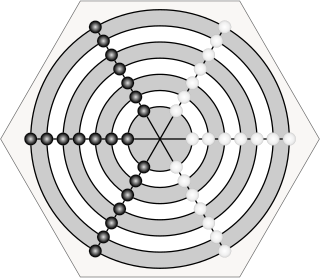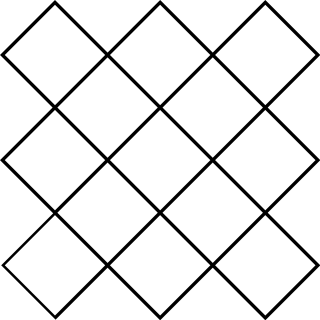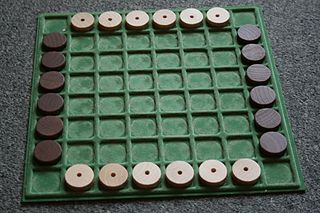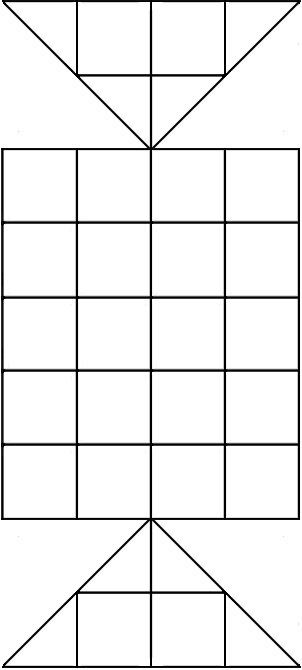
Epaminondas is a strategy board game invented by Robert Abbott in 1975. The game is named after the Theban general Epaminondas, known for the use of phalanx strategy in combat. The concept of the phalanx is integral to the game.
A Gamut of Games is an innovative book of games written by Sid Sackson and first published in 1969. It contains rules for a large number of paper and pencil, card, and board games. Many of the games in the book had never before been published. It is considered by many hobbyist gamers to be an essential text for anyone interested in abstract strategy games, and a number of the rules were later expanded into full-fledged published board games.
Crossings is a two-player abstract strategy board game invented by Robert Abbott. The rules were published in Sid Sackson's A Gamut of Games. Crossings was the precursor to Epaminondas, which uses a larger board and expanded rules.

Fields of Action is an abstract strategy board game for two players.

Focus is an abstract strategy board game, designed by Sid Sackson and first published in 1963 by Kosmos. The game has been re-published many times since, sometimes under the titles Domination or Dominio. Focus won the 1981 Spiel des Jahres and Essen Feather awards. The game appears in Sackson's A Gamut of Games in the section New Battles on an Old Battlefield.

Hasami shogi is a variant of shogi. The game has two main variants, and all Hasami variants, unlike other shogi variants, use only one type of piece, and the winning objective is not checkmate. One main variant involves capturing all but one of the opponent's men; the other involves building an unbroken vertical or horizontal chain of five-in-a-row.

The Game of the Generals, also called GG or GOG or simply The Generals, is an educational war game invented in the Philippines by Sofronio H. Pasola Jr. in 1970. Its Filipino name is "Salpakan." It can be played within twenty to thirty minutes. It is designed for two players, each controlling an army, and a neutral arbiter to decide the results of "challenges" between opposing playing pieces that have their identities hidden from the opponent.

Kōnane is a two-player strategy board game from Hawaii. It was invented by the ancient Hawaiian Polynesians. The game is played on a rectangular board. It begins with black and white counters filling the board in an alternating pattern. Players then hop over one another's pieces, capturing them similar to checkers. The first player unable to capture is the loser; their opponent is the winner.
Ming mang is a two-player abstract strategy board game from Tibet. Ming mang is also a general term for the word "boardgame" in Tibet. The correct name and spelling of the game may actually be Mig mang(s), but pronounced Ming mang or Mi Mang. The term mig mang is also applied to Tibetan go with both games using exactly the same board which is a 17 x 17 square board, and black and white pieces. Mig is in reference to the chart of the board, and Mangs refers to the notion that the more charts are used on the board, the more pieces are needed to play the game, but some state that it means "many eyes". The game may also be known as Gundru. The game was popular among some Tibetan monks before the Chinese invasion of Tibet in 1950, and the uprising in 1959, and among aristocratic families.

Blue and Gray is a strategy board game for two players invented by Henry Busch and Arthur Jaeger in 1903. They obtained a patent for the game, but may never have published it. The name Blue and Gray "refers to the uniforms of the South and the North in the Civil War and in the original game the playing pieces of the contestants were of those colors." Blue and Gray is a variant of checkers.
Pasang is a two-player abstract strategy board game from Brunei. The game is often referred to as Pasang Emas which is actually a software implementation of the traditional board game. The object of this game is to acquire the most points by capturing black and white tokens on the board. Black tokens are worth 1 point, and white tokens are worth 2 points. The board is initially laid out with all 120 black and white tokens in one of over 30 traditional patterns. Players choose a piece called a "ka" which is used to capture the tokens on the board. Each player's "ka" moves around the board capturing as many tokens as possible. As a note, the "kas" are the only mobile pieces in the game. The other pieces are stationary, and are captured by the "kas". Players must capture token(s) during their turn, or lose the game. When all tokens have been captured from the board, the player with the most points is the winner. However, if there are any tokens left on the board, and none can be captured on a player's turn, then that player loses the game, and the other player is the winner.

Gol-skuish is a two-player abstract strategy game from India, specifically from Central Provinces, and it was described by H.J.R. Murray in A History of Board-Games Other Than Chess (1952). The game belongs to the draughts and Alquerque family as pieces are captured by leaping over them. The board is composed of seven concentric circles divided by three diameters. Gol-skuish belongs to a specific category of games called Indian War-games which include Lau kata kati, Dash-guti, Egara-guti, and Pretwa. At the beginning of every Indian War-game all the pieces are laid out on the board at every intersection point, with the exception of the central point. This forces the first move of the game to be played on the central point, and captured by the second player's piece.
Jul-gonu is a two-player abstract strategy board game from Korea. It is one of many gonu games. The game has a relatively small board, and yet offers a challenge at different levels. The game could be played on a larger board, however, it tends to be tiresome. Jul means "lines", and the lines of the board are often drawn on the ground. The game is also referred to as "ne-jul-gonu", i.e. "four-lines gonu", referring to the four lines in each direction.

Liberian Queah is a two-player abstract strategy game from Liberia. It is specifically from the Mamba, Queah and Bassa tribes. The game is played on a slanted or diagonal square board with only 13 spaces. Pieces move "orthogonally" along these slanted or diagonal square boards. Another unique feature is that each player must have maximum four pieces on the board. Player's captured piece may resupplied with a piece from their reserve.
Cinc camins is a two-player abstract strategy game from northern China. Although played by children, there is a complexity and uniqueness to the game that adults can appreciate. The game may be related to the gonu (kono) games of Korea. These games use small boards, and have unique capturing rules.
Brax is a two-player abstract strategy board game. It was invented in 1889 in America by Frederic B. Denham of New York City. The board design is unique. The players move their pieces along paths on the square board; each path is one of two colors. A piece can move one or two spaces in a turn depending upon whether it matches the color of the path. Players attempt to capture each other's pieces.

Lines of Action is an abstract strategy board game for two players invented by Claude Soucie. The objective is to connect all of one's pieces into a single group. The game was recommended by the Spiel des Jahres in 1988.

Astar is a two-player abstract strategy board game from Kyrgyzstan. It is a game similar to draughts and Alquerque as players hop over one another's pieces when capturing. However, unlike draughts and Alquerqe, Astar is played on 5×6 square grid with two triangular boards attached on two opposite sides of the grid. The board somewhat resembles those of kotu ellima, sixteen soldiers, and peralikatuma, all of which are games related to astar. However, these three games use an expanded alquerque board with a 5×5 square grid with diagonal lines. Astar uses a 5×6 grid with no diagonal lines.
Bowling Solitaire is a patience or solitaire card game that uses a single deck standard playing cards to simulate a round of ten-pin bowling.
Tri-nim is a mathematical abstract strategy game developed by brothers Bruce L. Hicks and Hervey C. Hicks and published by WFF 'N PROOF Games from 1970 to 1975. Players move pieces around a triangular board, attempting to score points by being the last to enter each of the corners. It is a variation on the strategy game Nim.










